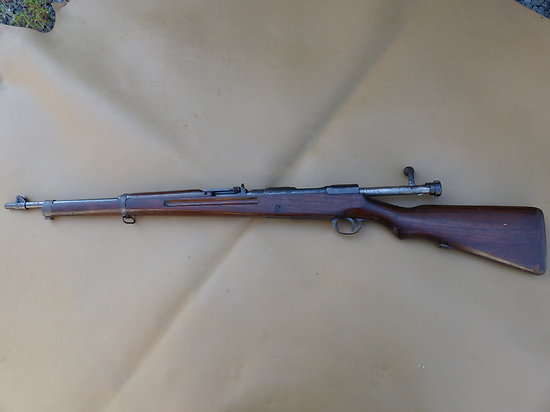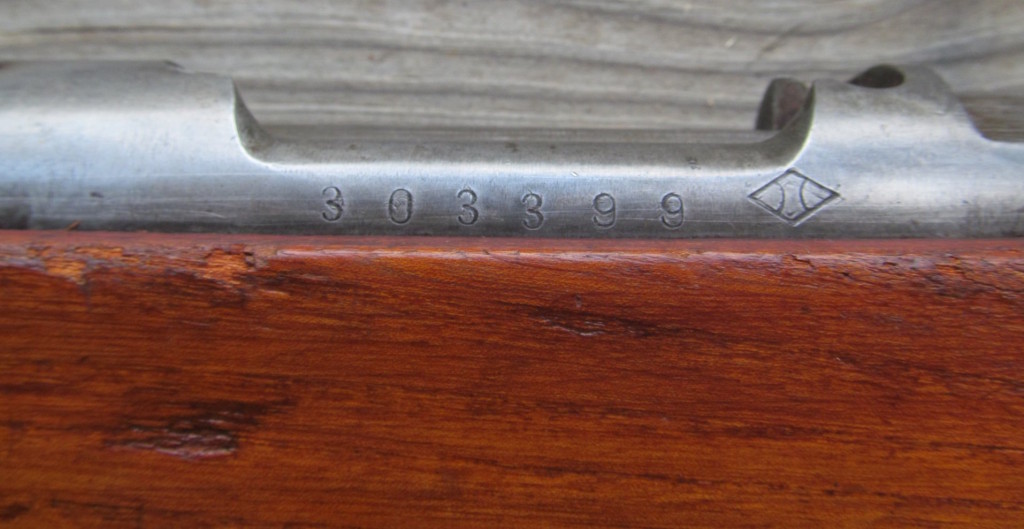North China Type 19 carbine
A relatively crude mix of the Type 38 and Type 99 that is believed to have been made mostly in the Chinese city of Tientsin and may have been intended for puppet troops. The Type 19 is in 6.5 Japanese, unlike its predecessor, the North China Type 30 carbine copy which is in 8mm Mauser. Like the North China Type 30, it has a cherry blossom on the breech instead of the Japanese Imperial Chrysanthemum, and is marked with “North China Type 19” (北支一九式) above the cherry blossom unlike the North China Type 30. The 19 may mean the 19th year of Showa Era or 1944. The true military designation is unknown. Approximately 43,000 carbines are thought to have been produced.------------------------------------------------------------------------------------- North China Type 30
July 26, 2016 Ian McCollum Bolt Action Rifles 22
When the Japanese invasion of China intensified in 1937, Imperial reliance on Chinese puppet troops for duties like garrisoning cities. Before long an estimated 500,000-900,000 such men were under the command of the Japanese, in both militia and regular army units. These men had to be armed, and Japanese domestic production of Type 38 (and later Type 99) rifles was all allocated to Japanese needs. Several solutions were found to the problem of arming the Chinese, including the extensive use of captured arms and also the organization of a domestic Chinese arms-making center in Tientsin.
From 1938 until 1943 (approximately; records are basically nonexistent) a conglomerate of at least five small factories in Tientsin produced about 38,500 North China Type 30 carbines. That name, by the way, is a US collector designation, as the official designation is not known. At any rate, the North China Type 30 was basically a Type 30 Arisaka chambered for the 8mm Mauser cartridge, as this was the ammunition most commonly available in China and the cartridge used by its national military before the Japanese invasion.

North China Type 30, left side

North China Type 30, right side
Only a small number of these rifles have been documented today, but we can make some inferences from them. For example, while fewer than 40,000 were made, they have serial numbers up to the 400,000 range. This is because each of the five arsenals or factories involved in the production was assigned a serial number block of a hundred thousand. The official Tientsin Arsenal made guns in the zero block (ie, starting at 0), with the other producers beginning at 100,000, 200,000, 300,000 and 400,000. If the leading digit is ignored, the highest recorded number is 16,503. This rifle, for example, is only the 3399th one produced in the 300,000 block (the names of these other factories are unknown).
Serial number and factory logo
These North China Type 30 rifles were made to a moderate level of quality, but to pre-war design standards. They use a flip-up ladder sight nearly identical to the Japanese Type 30, as well as steel buttplates, nicely finished sling swivels, etc. They do not have upper handguards, but that part was not included on the Japanese Type 30 either, as it was not deemed necessary.------ —
 Thai Type 83 rifle
Thai Type 83 rifle
Unlike the Siamese Type 66 (แบบ ๖๖), this rifle is a standard Japanese Type 38 in 6.5x50sr that was sent as aid from Japan to Thailand in 1940. These were taken straight from assembly lines at Nagoya and Kokura arsenals, after the Japanese Imperial Chrysanthemum was canceled out by zeros along the petals. In Thailand they called it the Type 83 (แบบ ๘๓). These rifles were issued to second-line troops to free up rifles in their main caliber from front line duties for the Franco-Thai War. Later in the 1950s, some of these rifles had their barrels and stocks cut down to short rifle length with many of those being rechambered for .30-06 Type 88 cartridge and becoming Type Type 83/88s (แบบ ๘๓/๘๘). Very few of these rifles were imported into the United States because of the Gun Control Act of 1968 restricting former military arms from entering the country.---------------------------------- Mexican Model 1913 rifle and carbine
Ordered in mid 1913 by the Huerta government in the standard Mexican military caliber, [7×57mm Mauser] (7×57mm Mauser - Wikiwand), for 50,000 rifles and later for another 25,000 carbines from the Tokyo Artillery Arsenal. They were made to fit the Mexican Mauser model 1895, 1902 or 1910 bayonets. Due to the Mexican Revolution, Japan instead sold them to Russia. The breech had the Mexican crest under “Republica Mexicana” where the Japanese Imperial Chrysanthemum would be on a Type 38 Arisaka. Early Model 1913s did not have three interlocking circles instead of the Mexican crest as reported in The Type 38 Arisaka (2007), with an early Model 1913 shown to have the Mexican crest.
Estonian KL .303
Estonian conversion of the standard Type 38 to the .303 British cartridge, intended for usage by second line troops of the Estonian Defence League. A total of 24,000 rifles were rebored during 1929–1934. 
